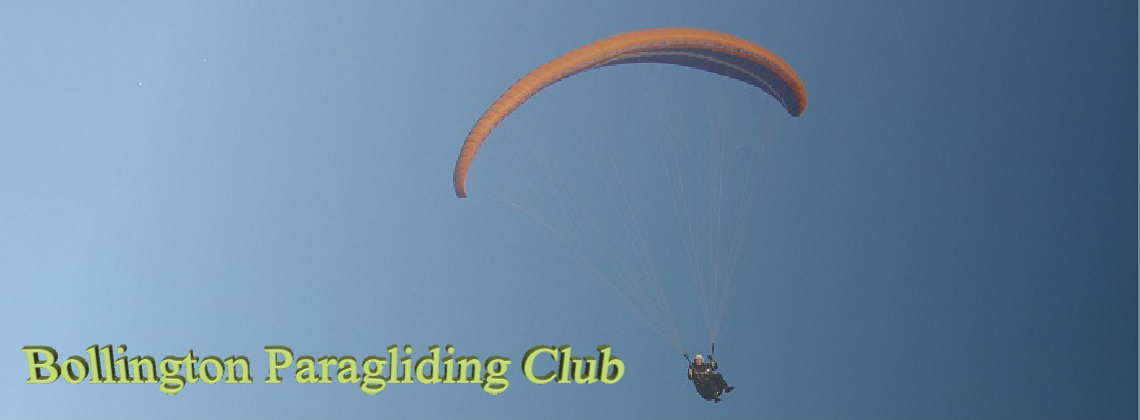


Site last updated 22/3/19
Formed 1st January 1973


3 Hours 17 minutes on the east face of Mam Tor
A rather windy morning on 3rd October did not look promising and after the usual debate as to which site to use, Neil Slinger and Mark Hobson settled on the east face of Mam Tor. Bill Morris reports that their decision was to result in a flight of 3 hours and 17 minutes.
To Neil the wind seemed too strong (about 20mph) for a large canopy so he choose to fly his Paramount 9/200 which he knew to be fast and have good penetration. After putting on his warm clothing and fixing his seat to his harness, he made a good clean launch about 200 feet below the top of the hill and found immediately that with a touch of brake he gained lift.
To start with he had to work hard, for though there was lift it was close to the hill and with the speed of the canopy he could easily fly out too far and loose it. the weather was fair, no clouds at first and with some thermal activity which gave Neil a 400 feet height gain at one stage but which also led to one loss of lift which he had to fight hard against, by turning back at the hill. He went looking for lift on the saddle between Mam Tor and Loose Hill but found that though there was lift he lost a lot of height getting there and then racing back to the better lift on the East Face.
The first hour passed quite quickly and the second hour seemed slightly easier, though Neil had to find ways of relieving the strain on his arms. He tried back risering, which was productive but needed too much arm strength. As a left hander he found his right arm started to hurt first, so he gripped his harness at half brake with his right hand and controlled the canopy purely by letting up or pulling on the left. As well as this he took both toggles in one hand and found this to be comfortable, possibly because the muscle groups he was using were different. Neil twisted his wrists to relax them and at one stage, feeling a bit of a wally, even flew with his arms straight out in front of him. He also developed a stiff neck looking around and behind as there was activity from aeromodellers and hang gliders, both of which he could see and posed no problems.
There were other canopies in the air from time to time and Neil did feel some dirty air in their wash, usually higher up which caught him by surprise. He was able to ride some of the better lift by small applications of brake, if he was blown too far backwards he used the speed of the canopy to fly forwards, sometimes in the downdraught and he describes the technique like being on a ferris wheel. Halfway through the second hour Neil was determined to do two hours and on passing that target set his mind on two and a half. He was feeling sorry for his observer Mark Hobson, who was waiting below, so he shouted down he would go for three hours and then come down. The shadows were getting longer and the wind getting more ragged with stronger gusts. This kept Neil switched on and he moved further out from the slope so that he had more height if he needed to recover from any instability.
The biggest problem of the day was getting down! Neil had picked a spot on the ground and had been trying to stay over it as this helped his concentration. After three hours he did an extra five minutes for any penalty and then started to descend. He had wanted to do a pure top landing but sensibly decided that with his tiredness and the effect of cold, he did not want to find himself struggling on the ground in the compression area on the top. He front risered to about 20 feet off the slope and balanced a landing onto the slope. He collapsed the canopy easily and sat down to regain his circulation in his arms and backside. Though tired, he was perfectly comfortable and after a rest walked the 60 metres to the top.
Neil felt he had picked the right canopy for his weight, 11 ½ stone, and the conditions. The flight, though strenuous was exhilarating and, he felt, achievable by anyone. Many of the hang gliders had seen his flight and were very impressed, and Neil was congratulated by members of the Sheffield HGC. Neil is a member of Bollington PC. He has flown a lot in the Peak District, and this flight replaced Neil's own existing national record of one hour and nineteen minutes, achieved on 20th June at Parlick Pike in Lancashire. Neil currently leads the Parascending Duration League and his total time, without this score, is 175 minutes over five flights. There are currently at least five people who have done the hour in the UK and maybe one day someone will stay up all day. Neil is to be congratulated on this time. He has shown what is possible and started to show the kind of skills that will have to be learnt for the future. His next plans include some distance flights along ridges before tackling the idea of cross country flights. It couldn't happen to a nicer guy!
Steve Thompson of Sheffield Hang Gliding Club, who also took photographs comments : "Surely the next important step in foot launched canopy soaring will be when someone manages to soar from dawn to dusk, enabling the emphasis to move from duration to much more interesting records : height gain, distance... There is, for example, the potential for some quite interesting out and return flights along ridges."
Source : Skywalker Sept to October 1987.

Mam Tor 1987






